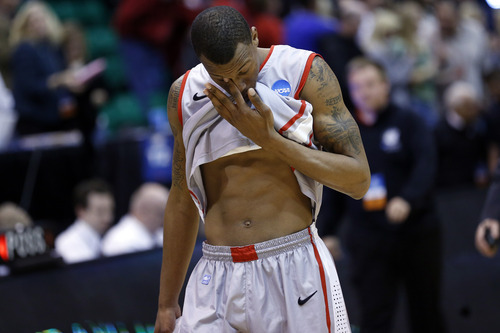This is an archived article that was published on sltrib.com in 2013, and information in the article may be outdated. It is provided only for personal research purposes and may not be reprinted.
There are all kinds of things to love about what we've seen thus far in the NCAA Tournament games at EnergySolutions Arena. Too bad the basketball itself isn't one of them.
The atmosphere is great. ... The setting is great. ... The cheerleaders are great. ... The Southern University band, also known as the Human Jukebox, is great. How often do you see a band get a standing ovation? ... The visiting fans from far-flung locations decked out in their gear are great. ... The mascots are great, with the exception of the Wichita State Shocker dude, who looks like he emerged out of a bad horror flick. ... The competitive care-factor is great. ... The immediacy is great. ... The emotion is great, both the raw expression of ecstasy in victory and the absolute heartbreak of defeat, one extreme illustrated so clearly by Harvard's Christian Webster after the Crimson beat New Mexico and the other by Pitt senior guard Tray Woodall, who broke down and cried during a news conference after the Panthers' loss.
Cool. Cool. And cool.
All of that is everything the NCAA Tournament always has been.
But watching the four games so concentrated on Thursday also painted a picture of college basketball that isn't so cool. The level of offensive play falls, in a general sense, as far short as one of the Lobos' jump shots fired up and off against Harvard. And the Lobo shanks weren't the only ones.
At times, the whole thing was hard to watch.
Pitt, a team that was supposed to have one of the most efficient offenses in the country, shot 30 percent in the first half against Wichita State and 35 percent for the game. And that includes the layups. Accurate shooting from distance was ridiculously rare, even a stunning surprise on the few occasions when the ball actually hit the net. The Shockers, who won, shot just 38 percent. Those teams combined to hit 3 of 37 attempts from behind the 3-point arc. Pitiful and pitiable. They also combined for 19 assists against 26 turnovers.
Ugh.
They weren't alone.
In Gonzaga's win over Southern, the teams totaled 41 made shots and 101 misses. There were a mere 10 combined points scored in transition.
Belmont, a team that led the nation in shooting percentage on 2-point shots (57 percent) during the regular season, heaved the ball up here as though its players were wearing boxing gloves. The Bruins made just 39 percent of their attempts in their loss to Arizona. Neither of those teams had more assists than turnovers.
And the poor New Mexico Lobos hit just 21 of 56 tries in their defeat at the hands of Harvard, including 3 of 14 from 3.
The Crimson and Wildcats were the only teams to shoot better than 41 percent.
Taken together, the eight teams playing in Salt Lake City on Thursday made 171 field goals out of 404 attempts. From beyond the arc, which in college ball is 20 feet, 9 inches out, three feet closer to the basket than the NBA 3, the teams made 49 of 156 tries.
They turned over the ball 91 times to 82 assists.
The average score in the four games was 71-59.
Defense in college, at least in a pressurized setting such as the tournament, is far superior to the offense, apparently, and that sometimes makes the game difficult to enjoy. But that still doesn't explain so many missed open shots, so many blown attempts from 10 feet and in, and so many teams chucking the ball around as though it was a greased globe of radioactive waste.
The passion of the NCAA Tournament is undeniable and worth embracing.
The precision, though, is unremarkable and worth forgetting.
Gordon Monson hosts "The Big Show" weekdays with Spence Checketts from 3-7 p.m. on 97.5 FM and 1280 and 960 AM The Zone. Twitter: @GordonMonson. NCAA Tournament live blog
What's happening right now in the NCAA Tournament? Jump into our live blog anytime and get a snapshot of not only what's going on, but what folks are buzzing about as well.



